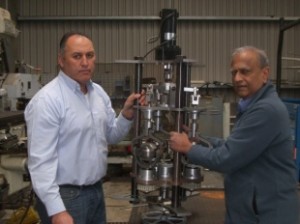Revolutionary wind power invention receives international recognition
Jega Jegatheeson (left) with Tony Herewini, general manager, T P Engineering.
 A New Zealand invention, designed to make wind power more efficient and cheaper, has been singled out by a renowned wind technology expert as one of the world’s leading new innovations.
A New Zealand invention, designed to make wind power more efficient and cheaper, has been singled out by a renowned wind technology expert as one of the world’s leading new innovations.
The invention, Gyroscopic Variable Transmission (GVT), is the brainchild of New Zealander Mr Jega Jegatheeson. It has been featured in a new book, ‘Innovation in Wind Turbine Design’, by Glasgow-based wind expert Peter Jamieson, as being on the leading edge of wind power technology.
Mr Jegatheeson, previously an engineer with the former Electricity Corporation of New Zealand, has been working for over 15 years to solve the problems faced by the wind power industry of gearboxes breaking as a result of the massive wind gust forces they are subjected to.
“It’s widely recognised in the industry that the gearboxes cannot stand up to the incessant forces over time and many fail within as little as five to seven years. The costs of repairs and also the downtime are very significant and alternatives such as direct drive create other expensive problems,” says Mr Jegatheeson.
“Unlike traditional wind turbine gearboxes around the world, GVT technology doesn’t rely on gears and expensive electronics. It instead uses gyroscopic reaction forces to transfer the power from the blades to the generator with less stress on the turbine. This will significantly reduce costs – possibly as much as 50% compared to existing systems.”
Another feature of GVT is that it can handle more turbulent air. This means that wind turbines equipped with the GVT technology could be built on the edges of existing wind farms in places previously thought unsuitable. The result would mean significant increases in energy generated from an existing wind farm using the same infrastructure.
“Developing our technology in New Zealand has been difficult, says Mr Jegatheeson. “It’s been a struggle to find funding because there are not many local investors prepared to take the risks associated with developing a new technology – even though the potential is huge.
“We are currently trying to raise funds to build a large GVT transmission and test it in a full size working wind turbine. A major New Zealand power company has offered us a turbine for the trial, but the problem, as always, is the funding. We now have to look overseas and have interest from China and the UK at present. That’s the reality of developing such challenging technologies in a small country,” says Mr Jegatheeson.
“Wind power is growing at a phenomenal rate worldwide and it would be nice if a New Zealand invention could be powering the wind turbines of the future.”
GVT has far reaching capabilities beyond wind power and can also be used for wave power and heavy transport.



